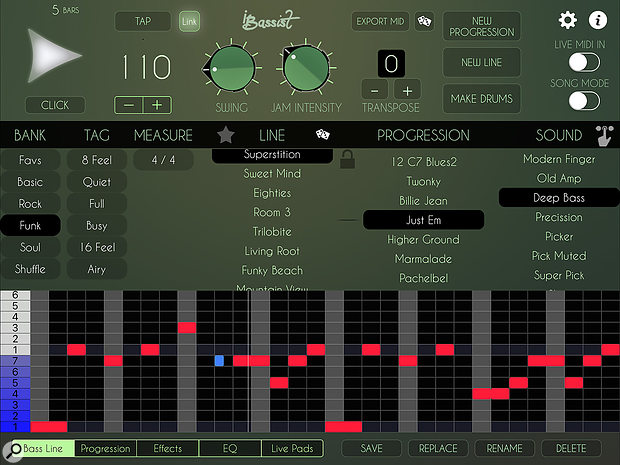 We’re not saying you have to fire your bass player, we’re just saying it’s an option...
We’re not saying you have to fire your bass player, we’re just saying it’s an option...
While virtual drummers are now part of the music technology furniture, non-drum virtual instruments that provide automatic musical accompaniment are a little thinner on the ground under iOS. Thankfully, with iBassist from Luis Martinez (under his Lumbeat development label), we have an iOS candidate that falls into this category.
Luis has a well-established line of virtual drum instruments on the App Store, each covering a different musical genre. These are all very good and, while they don’t perhaps challenge the likes of Toontrack’s SD3 in terms of sonic details, they make up for it by being streamlined to fit the iPad format, very easy to use, relatively inexpensive and very creative. Fans of these drum apps will therefore be very interested to try iBassist as it brings the same features — and, indeed, a similar UI/workflow — to the role of virtual bass player. And, if used alongside one of the drum apps (I used Rock Drum Machine for my own testing), the two apps sync perfectly with a super-slick means of getting the drum part/performance to follow the style of the bass line.
In essence, iBassist provides a combination of sample-based bass guitar sounds (including a double bass), an extensive collection of style-based preset bass lines, and a preset series of chord progressions to get you started. As suggested by the pattern grid that fills the bottom half of the main display, the bass lines are created by scale degrees (intervals) and, as a result, can pick suitable notes to follow your chord changes. The bass line presets include some titles where the source of inspiration is pretty obvious (for example, ‘Seven Nation’ or ‘Superstition’) but there are also lots of very musical generic lines. You can, of course, create and save your own and the pattern editing grid is really easy to use.
The preset chord progressions also cover a good range of styles but tapping the New Progression button lets you build your own very easily with plenty of chord styles available. The app also offers a chord detection mode where you can play in a chord progression from a suitable MIDI source. I couldn’t seem to get that working with my own MIDI keyboard, but it would certainly be a useful alternative to creating sequences by hand for those with suitable keyboard skills.
As well as a very good selection of effects, other major features worth a mention are the Song Mode and Live Pads. Song Mode allows you to chain individual chord sequences/bass line combinations into a full song structure. In contrast, with the Live Pads, you have eight slots that can each hold a chord progression/bass line combination and you can then trigger these ‘live’, either from the touchscreen or an external MIDI keyboard. This is great for a bit of a live jam vibe.
Is iBassist going to put a few session bassists out of work? Well, perhaps not. However, I can easily see it sat alongside one of Luis’ drum apps and making a very cool personal jam tool, as a songwriting aid (the app offers MIDI out for transfer to a DAW/sequencer) and, for solo musicians, being a neat way to carry a compact ‘backing band’ around to small-scale gigs. It’s a shame that, as yet, none of the Lumbeat apps offer AU support, but IAA and Audiobus support are included. Hopefully, AU will come but, even so, iBassist is an excellent addition to the app collection of any iOS musician who uses electric bass within their music making.
£17.99
$17.99
